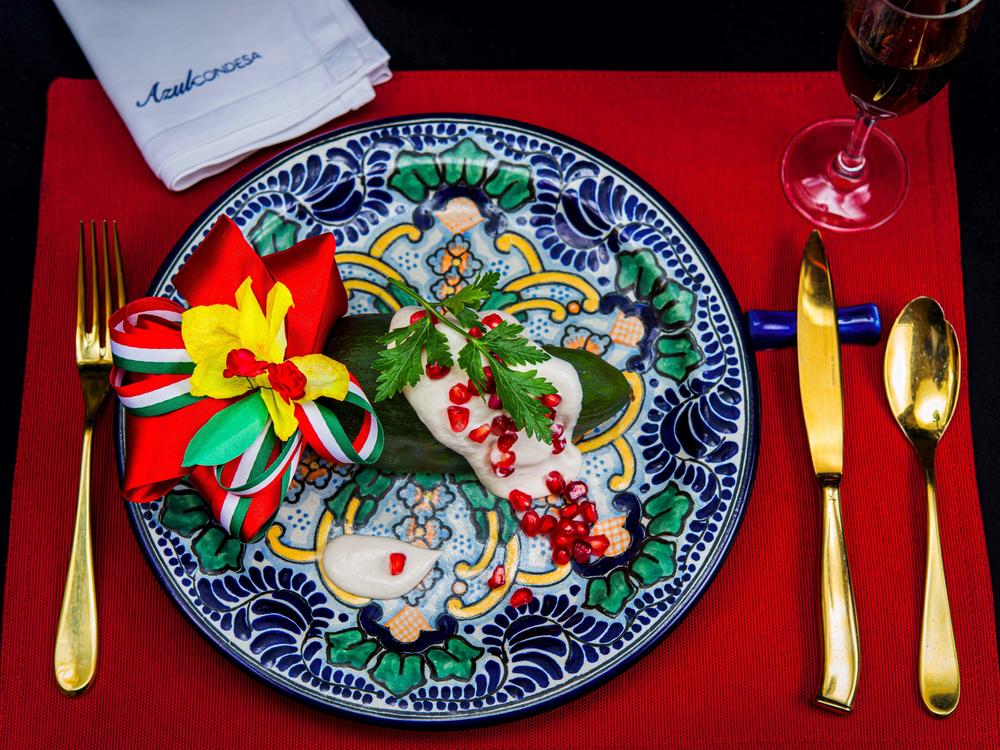Section Branding
Header Content
For 200 Years, Chiles En Nogada Has Been An Iconic, And Patriotic, Mexican Meal
Primary Content
Shortly after signing the August 1821 treaty that formally established Mexico's independence from Spain, Agustín de Iturbide paid a visit to the city of Puebla.
Legend has it that the nuns of a local convent prepared the leader of the Mexican Army — and soon to be the country's first emperor — a pepper dish that reflected the three colors of the Mexican flag.
There was the green of the poblano pepper, which is stuffed with meat, fruits and nuts; the white of the creamy walnut sauce that smothers it; and red in the pomegranate seeds scattered on top. He loved the dish — and 200 years ago, an iconic meal was born.
"It's a recipe that continues to be loved and passed on," says Pati Jinich, the Mexican chef, TV host and cookbook author. "And it's an heirloom of Mexican cuisine and culture."
So much so that today, chiles en nogada is the entrée of choice for celebrations of Mexico's Independence Day, Sept. 16 — and not just for its color scheme.
Jinich points out that many ingredients are in season during August and September – the walnuts and pomegranate in particular, but also many of the fruits native to Puebla that go into the complex stuffing. And she also notes that it's a particularly labor-intensive meal suited to eating at a restaurant or preparing on a day off.
The peppers may be fire-roasted, then peeled and cut; some versions even call for battering and frying. The picadillo used as stuffing is unusual, and involves more ingredients than are typically used in the minced meat dish.
One traditional version calls for acitrón, which comes from a now-endangered cactus. It's common to substitute candied pineapple, Jinich says.
And there's the walnut sauce, or nogada, which takes a long time to make — and even longer if the nuts need to be shelled.
"It's truly a celebration dish," Jinich says. "It's not something that you're going to whip up on a Tuesday night."
Jinich describes chiles en nogada as a marriage between ingredients and cooking techniques of the Old World and the New World. The roasted peppers and the flavor combination of "the super-sweet, the super-spicy, the super-savory" strike her as quintessentially Mexican.
But it also has European ingredients brought from Spain: olives, capers, walnuts from Castille, Jinich says. "I mean, it's truly Mexican. But at the same time, it really embraces the history of Mexico ... the pre-Hispanic Mexico and then the colonial Mexico."
About that: In his recipe anthology Los Chiles Rellenos en México, Mexican chef and food historian Ricardo Muñoz Zurita cites 18th century record-keeping that chiles en nogada actually predate the future emperor's visit to Puebla. But Muñoz does tell the story of the emperor's visit to the convent in Puebla — a region that was and remains a culinary hotspot.
"Puebla is really one of the cradles of traditional Mexican cuisine," Jinich says. "Many of the cooks that live in the U.S. also come from Puebla. In fact, I've heard New York being called Puebla York."
Jinich, who is Jewish, will observe a doubleheader this year — the solemn fast of Yom Kippur and celebration of Independence Day both fall on Sept. 16.
But she won't miss out on the tradition. She started freezing pomegranate seeds last winter for the chiles en nogada feast she had on the 15th. She says she hopes it'll sustain her through her Yom Kippur fast.
Copyright 2021 NPR. To see more, visit https://www.npr.org.

